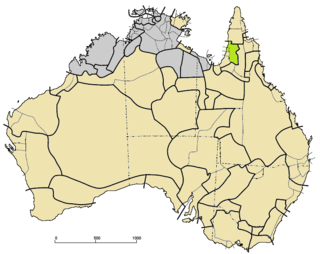Related Research Articles
Errk Oykangand is a national park in Queensland, Australia, 1748 km northwest of Brisbane. Today, this protected area is jointly managed by the Queensland government and the traditional Aboriginal owners, the Kunjen and Oykangand People.

The Mitchell River is a river in Far North Queensland, Australia. The river rises on the Atherton Tableland about 50 kilometres (31 mi) northwest of Cairns and flows about 750 kilometres (470 mi) northwest across Cape York Peninsula from Mareeba to the Gulf of Carpentaria.
The Bigambul people are an Aboriginal Australian people of the Northern Tablelands and Border Rivers regions of New South Wales and Queensland.

Kowanyama is a town and coastal locality in the Aboriginal Shire of Kowanyama, Queensland, Australia.
Yir-Yoront was a Paman language spoken in two settlements, Kowanyama and Pormpuraaw on the southwestern part of the Cape York Peninsula, Queensland in Australia, by the Yir-Yoront people. In 1991 only 15 speakers remained, with the rest of the Yir-Yoront people speaking English or even Kuuk Thaayorre as many speakers of Yir-Yoront apparently are using Kuuk Thaayorre in daily conversation. At present it is thought to be extinct. There are two sister dialects, Yir-Yoront proper and Yirrk-Thangalkl, which are very close. The shared name Yir is sometimes used for both taken together.

The Tharawal people and other variants, are an Aboriginal Australian people, identified by the Yuin language. Traditionally, they lived as hunter–fisher–gatherers in family groups or clans with ties of kinship, scattered along the coastal area of what is now the Sydney basin in New South Wales.
The Gidabal, also known as Kitabal and Githabul, are an indigenous Australian tribe of southern Queensland, who inhabited an area in south-east Queensland and north-east New South Wales, now within the Southern Downs, Tenterfield and Kyogle Local Government regions.
Kunjen, or Uw, is a Paman language spoken on the Cape York Peninsula of Queensland, Australia, by the Uw Oykangand, Olkola, and related Aboriginal Australian peoples. It is closely related to Kuuk Thaayorre, and perhaps Kuuk Yak.

The Aboriginal Shire of Kowanyama is a special local government area which is located on western Cape York Peninsula in Queensland, Australia. It is managed under a Deed of Grant in Trust under the Local Government Act 2004.

The Southwestern Paman languages are a family of the Paman languages spoken on the western part of the Cape York Peninsula of Queensland, Australia.
The Yir-Yoront, also known as the Yir Yiront, are an Indigenous Australian people of the Cape York Peninsula now living mostly in Kowanyama but also in Lirrqar/Pormpuraaw, both towns outside their traditional lands.
The Thaayorre, or Kuuk Thaayore, are an Australian people living on the southwestern part of the Cape York Peninsula, Queensland in Australia, primarily in the settlement Pormpuraaw, having its foundation in the Edward River Mission.
The Coleman River is a river on the Cape York Peninsula in Far North Queensland, Australia.
The Olkolo or Koko-olkola' are an Indigenous Australian people of central and eastern Cape York Peninsula in northern Queensland. According to Norman Tindale, they are to be distinguished from the Kokangol, higher up on the Alice River watershed.
The Kokangol (Koko-Gol), or Yuwula, are said to have been an Indigenous Australian people of Queensland. Some dispute this, suggesting the name may be a synonym for Aghu Tharnggala, or may simply be the name of a language consultant.
The Ajabakan were an indigenous Australian people of the Cape York Peninsula of Queensland.
The Wanggamala people, also spelt Wangkamahdla, Wangkamadla, Wangkamanha, Wangkamana, Wonkamala, Wongkamala, Wonkamudla, and other variants, are an Aboriginal Australian people of the Northern Territory and Queensland.
Muragan is an indigenous Australian ancestral deity from North-Eastern Australia. Its worshipers may have spoken Kunjen, or some Kunjen dialect. The Australian Muragan is also believed to be the progenitor of the Tamil-Indian Murugan. Muragan is believed to have been the name of an actual people from the state of Queensland.
The Gugu Rarmul were an indigenous Australian people of the state of Queensland, one of several whose speech was called Gugu Yawa.
The Ngundjan (Ogh-Undjan) were an indigenous Australian people of the state of Queensland.
References
- 1 2 3 Tindale 1974, p. 179.
- 1 2 AustKin.
- ↑ Alpher 1993, pp. 97–106.
- ↑ Sommer 1981, pp. 231–244.
- ↑ Crump, Des (10 August 2020). "Language of the Week: Week Eleven - Oykangand". State Library Of Queensland. Retrieved 15 December 2023.
- ↑ Strang 2013, pp. 15–16.
- 1 2 Oldham et al. 2013, p. 41.
- ↑ Strang 2013, p. 89.
- ↑ Strang 2013, p. 90,117 n.4.
- ↑ Strang 2013, p. 16.
- ↑ Strang 2013, p. 101.